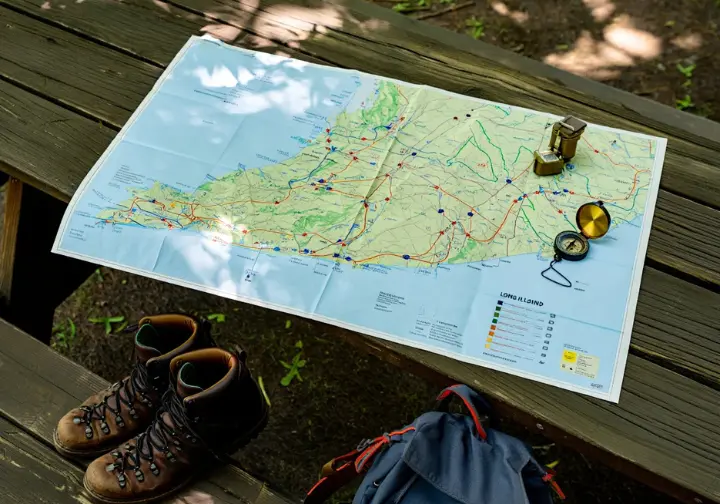In this article
This guide dismantles the myth that Long Island is just a flat expanse of suburbs and beaches. We’ll reveal the surprisingly diverse and extensive network of hiking trails Long Island has, from the rugged, hilly bluffs of the North Shore to the unique ecosystems of the Central Pine Barrens and the wild barrier island beaches of the South Shore. This article is your definitive resource for planning any hike on Long Island, offering not just trail recommendations for the best hikes on Long Island, but the practical knowledge needed for a safe and rewarding adventure.
The Premier Hikes of Long Island: A Curated Guide

To help you find the perfect outing, we’ve broken down the island’s premier trails by their distinct geographical character. Many agree that Suffolk probably has the best places to hike. Each entry in our list of walking trails Long Island offers includes essential stats, highlights, and our unique Long Island Hiking Challenge Scale to match you with the right trail for your skill level and interest, whether you’re looking for a short walk or a longer trek.
North Shore Bluffs & Hills: Elevation and Vistas
These walking trails, shaped by the Harbor Hill glacial moraine, offer the most significant elevation gain on Long Island. They reward hikers with stunning, picturesque views of the Long Island Sound and historic harbors.
Cold Spring Harbor State Park is the undisputed champion for those seeking a strenuous workout. Its main loop is famous for its steep hills and staircases, often used by athletes for training, making it a truly challenging hike that requires physical preparation. The path winds through a beautiful hardwood forest and connects to the Nassau-Suffolk Greenbelt Trail for longer treks, with options from 2.0 to 5.3 miles. We rate it a definitive LI-5. Highlights include the most difficult elevation on the island and beautiful harbor views from the woods. Dogs are welcome on a leash, but it’s wise to check the official park rules and regulations.
At Caumsett State Historic Park Preserve, you can hike through the Gilded Age on the former estate of Marshall Field III. This 1,520-acre preserve offers miles of paved paths and unpaved routes through woodlands, meadows, and along a rocky shoreline with incredible bluff views. The relatively flat terrain, rated LI-1 to LI-2, makes it accessible for all skill levels. The main draw is the blend of natural beauty, historic Gilded Age estate buildings, and diverse wildlife habitats. Dogs are not permitted here. For logistics, check details on accessing the historic park preserve.
Sunken Meadow State Park is famous for its boardwalks and iconic beach, but it also boasts surprisingly hilly and scenic woodland trails on its western end. These bluff-top hiking trails climb high, offering panoramic views of the Long Island Sound across to Connecticut. The state park entrance is off the Sunken Meadow Pkwy. The park offers diverse experiences from an easy stroll (LI-1) to challenging bluff climbs (LI-4). It’s also the northern terminus of the 32-mile Long Island Greenbelt Trail system. You can enjoy sweeping bluff-top views and a mix of flat and hilly trails, including flat beach walks. Leashed dogs are allowed in designated areas. It’s helpful to review the Sunken Meadow trail map PDF before you go.
South Shore & Coastal Paths: Dunes, Beaches, and Maritime Forests
Experience the wilder side of Long Island’s famous coastal region with these hikes that traverse sandy beaches, pristine ocean dunes, and globally rare maritime forests on the island’s barrier beaches.
Fire Island offers two premier hiking experiences within the Fire Island National Seashore. The Sunken Forest is a 1.5-mile boardwalk trail (LI-1) through a globally rare maritime holly forest. For a longer trek, the 7-mile Burma Trail (LI-3) is a sandy footpath that winds through the Otis Pike Fire Island High Dune Wilderness, offering solitude and a true beach hiking adventure. The seashore is known for exceptional birdwatching. Dogs are not allowed in the Sunken Forest but are permitted on leash in the Wilderness. Before you go, check ferry schedules for visiting the Sunken Forest or learn about hiking the Burma Trail.
The “End of the World” at Montauk Point State Park & Camp Hero State Park offers a spectacular blend of landscapes rated LI-2 to LI-3. Hike the several trails at Montauk Point for iconic Montauk Point Lighthouse views and paths that wind along bluffs and a rocky beach. Adjoining Camp Hero offers a different experience, with miles of trails through maritime forest and heathland. Here you can explore the eerie, abandoned remnants of a WWII and Cold War military base, including a large concrete bunker. Famous lighthouse views and historic military bunkers are the key highlights. Leashed dogs are welcome.
The Pine Barrens Interior: A Forest Forged by Fire
Explore Long Island trails in its largest wilderness area, the Central Pine Barren region. This unique, fire-dependent ecosystem protects Long Island’s purest drinking water and offers miles of flat, sandy nature trails through pitch pine and scrub oak forests.
The adjacent Rocky Point Pine Barrens State Forest & Brookhaven State Park offer an extensive network of wide, sandy trails perfect for long, peaceful hikes. The terrain is mostly flat but sandy (LI-2), which can make for a surprisingly tiring workout. These trails are part of the 125-mile Paumanok Path and are ideal for those seeking solitude and a deep immersion in this significant natural sanctuary. The area’s existence is a testament to the work of protecting the Central Pine Barrens. Dogs on leash are permitted.
Unique Preserves: Ecological and Community Treasures
These special places are often managed by non-profits and offer some of the most pristine landscapes on the island, showcasing the success of local conservation efforts.
Mashomack Preserve on Shelter Island is often called the “Jewel of the Peconic.” This 2,039-acre preserve managed by The Nature Conservancy covers nearly one-third of the island. It features 11 miles of coastline and well-marked trails (LI-2) from 1.5 to 10 miles long that wind through tidal creeks, salt marshes, and woodlands. The preserve is a critical habitat for many species, and its scenic views make it an ideal spot for birdwatching. Dogs are not allowed. It is recommended to check the rules before visiting the Mashomack Preserve.
Gearing Up & Staying Safe: Your Long Island Hiking Playbook

Proper preparation is non-negotiable for a safe and enjoyable trip on Long Island. We’ll address the most common concerns and provide hyper-specific advice for the island’s unique environmental challenges, from gear selection to the most critical safety protocol: tick prevention.
The Hyper-Specific Long Island Gear Guide
Forget generic advice. The combination of sandy beaches and tick-infested woodlands requires a specific approach to gear. Getting this right makes for a safer trip. For footwear, while sturdy boots are a classic choice, many local hikers prefer dedicated hiking shoes or trail shoes. They are lighter, but the key is managing sand. Pairing them with lightweight gaiters creates a seal that effectively keeps out sand. For clothing, layering is a must. The number one priority is tick prevention, so light-colored clothing and long pants treated with permethrin are essential. Many hikers also use trekking poles to help on uneven trails and sandy terrain.
The Ultimate Guide to Tick Safety on Long Island
Long Island is, as one hiker put it, “supreme (and terrifying) in its tickiness.” Do not underestimate the risk. Following a strict protocol is the most important safety measure you can take. Your protocol should begin before you hike by treating clothes with permethrin. For full protection, wearing long pants is a wise choice. On the trail, stay in the center of paths. The most critical step happens after the hike. Immediately put clothes in the dryer on high heat, then perform a full-body check. For more information, you can consult the official county guidance on ticks.
Essential Logistics and Trail Etiquette
A smooth trip starts with knowing the rules. Most NYS Parks charge a vehicle fee ($8-$10) in season at the park entrance. Always check the official park website for current hours and facilities. The state also provides Hike Smart NY safety and essentials to help you prepare. Adhering to the seven principles of Leave No Trace is the gold standard for trail etiquette; this includes a rule to leave rocks, plants, and other natural objects as you find them. Many trails are dog-friendly, but leashes are required. The official Suffolk County Parks hiking page is a good resource.
Your Car-Free Hiking Planner: Reaching Trails by Public Transit

Getting to the trailhead without a car can be frustrating. Our consolidated guide provides a unique resource for visitors coming from NYC or anywhere else via public transit, solving that problem.
The Long Island Trail-by-Train Guide
The LIRR can get you surprisingly close to some of the best hiking trails Long Island offers. Reaching the trailhead from the station—the “last mile”—is the key logistical challenge. The table below helps you plan your car-free adventure. “Walkable” means you can reasonably walk, but “Taxi/Rideshare recommended” means the distance is significant. Always confirm schedules and get directions before you leave. Helpful information can be found through public transit resources for trails and the local Suffolk County’s Transit to Trails guide.
Hiking on Long Island via the LIRR
Filter by train line to find parks accessible by public transport.
Cold Spring Harbor State Park
A hilly, wooded park offering a good workout with views of the harbor.
Massapequa Preserve (South)
A long, flat, and paved path perfect for easy walks, runs, and bike rides.
Connetquot River State Park
A massive preserve with miles of flat, sandy trails through pine barrens.
Bayard Cutting Arboretum
Stunning, manicured grounds with easy, paved paths along the Connetquot River.
Sunken Meadow State Park
Features a popular boardwalk, sandy beach, and bluffs overlooking the Long Island Sound.
Key Takeaways for Hiking on Long Island
Long Island is a premier hiking destination hiding in plain sight. Its diverse landscapes offer something for every hiker. The true magic lies in its variety; you can hike oceanfront bluffs in the morning and a pine forest in the afternoon. Your enjoyment and safety hinge on being prepared for local conditions, so master the tick protocol and choose the right footwear. The experience is enriched when you understand the geology, ecology, and history of the land. Finally, remember these favorite places exist because of conservation, so practice Leave No Trace and be a steward of the trails.
Popular Questions
Are there really challenging, hilly hikes on Long Island? +
What is the single most important safety concern for Long Island hiking? +
Can I go hiking on Long Island without a car? +
What is the best season for hiking on Long Island? +
We are a participant in the Amazon Services LLC Associates Program, an affiliate advertising program designed to provide a means for sites to earn advertising fees by advertising and linking to Amazon.com. As an Amazon Associate I earn from qualifying purchases. We also participate in other affiliate programs. The information provided on this website is provided for entertainment purposes only. We make no representations or warranties of any kind, expressed or implied, about the completeness, accuracy, adequacy, legality, usefulness, reliability, suitability, or availability of the information, or about anything else. Any reliance you place on the information is therefore strictly at your own risk. Additional terms are found in the terms of service.











